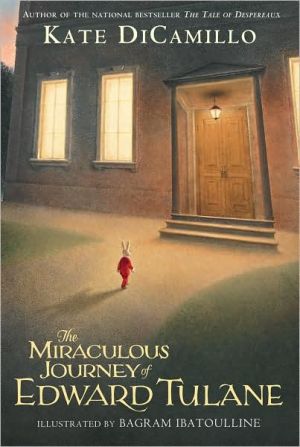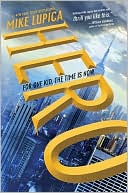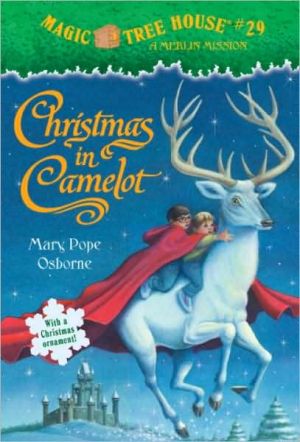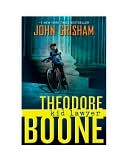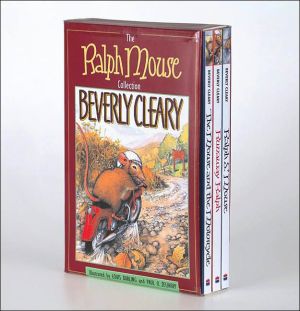The Miraculous Journey of Edward Tulane
Once, in a house on Egypt Street, there lived a china rabbit named Edward Tulane. The rabbit was very pleased with himself, and for good reason: he was owned by a girl named Abilene, who treated him with the utmost care and adored him completely.\ And then, one day, he was lost.\ Kate DiCamillo and Bagram Ibatoulline take us on an extraordinary journey, from the depths of the ocean to the net of a fisherman, from the top of a garbage heap to the fireside of a hobies' camp, from the bedside...
Search in google:
Once, in a house on Egypt Street, there lived a china rabbit named Edward Tulane. The rabbit was very pleased with himself, and for good reason: he was owned by a girl named Abilene, who adored him completely. And then, one day, he was lost. . . . Kate DiCamillo takes us on an extraordinary journey, from the depths of the ocean to the net of a fisherman, from the bedside of an ailing child to the bustling streets of Memphis. Along the way, we are shown a miracle — that even a heart of the most breakable kind can learn to love, to lose, and to love again.The New York Times - Michael Patrick HearnDiCamillo's latest novel, The Miraculous Journey of Edward Tulane, may well be her best. It is an elegant volume of creamy pages with a handsome typeface and generous margins in a pale green binding. Bagram Ibatoulline's haunting color plates and sepia illustrations at the beginning of each chapter evoke the era of Andrew Wyeth, Howard Pyle and Maxfield Parrish. The novel is set in the storybook land of no specific time or locale. There are no annoying cellphones or Starbucks cafes. Not even the pictures give a clue to the exact period covered by the events. It could be the America of the Great Depression reconstructed on a vast Hollywood back lot.
The Miraculous Journey of Edward Tulane\ \ By Kate DiCamillo \ Candlewick Press\ Copyright © 2006 Kate DiCamillo All right reserved.\ ISBN: 0-7636-2589-2 \ \ \ Chapter One\ Once, in a house on Egypt Street, there lived a rabbit who was made almost entirely of china. He had china arms and china legs, china paws and a china head, a china torso and a china nose. His arms and legs were jointed and joined by wire so that his china elbows and china knees could be bent, giving him much freedom of movement. \ His ears were made of real rabbit fur, and beneath the fur, there were strong, bendable wires, which allowed the ears to be arranged into poses that reflected the rabbit's mood-jaunty, tired, full of ennui. His tail, too, was made of real rabbit fur and was fluffy and soft and well shaped.\ The rabbit's name was Edward Tulane, and he was tall. He measured almost three feet from the tip of his ears to the tip of his feet; his eyes were painted a penetrating and intelligent blue.\ In all, Edward Tulane felt himself to be an exceptional specimen. Only his whiskers gave him pause. They were long and elegant (as they should be), but they were of uncertain origin. Edward felt quite strongly that they were not the whiskers of a rabbit. Whom the whiskers had belonged to initially-what unsavory animal-was a question that Edward could not bear to consider for too long. And so he did not. He preferred, as a rule, not to think unpleasantthoughts.\ Edward's mistress was a ten-year-old, dark-haired girl named Abilene Tulane, who thought almost as highly of Edward as Edward thought of himself. Each morning after she dressed herself for school, Abilene dressed Edward.\ The china rabbit was in possession of an extraordinary wardrobe composed of handmade silk suits, custom shoes fashioned from the finest leather and designed specifically for his-rabbit feet, and a wide array of hats equipped with holes so that they could easily fit over Edward's large and expressive ears. Each pair of well-cut pants had a small pocket for Edward's gold pocket watch. Abilene wound this watch for him each morning.\ "Now, Edward," she said to him after she was done winding the watch, "when the big hand is on the twelve and the little hand is on the three, I will come home to you."\ She placed Edward on a chair in the dining room and positioned the chair so that Edward was looking out the window and could see the path that led up to the Tulane front door. Abilene balanced the watch on his left leg. She kissed the tips of his ears, and then she left and Edward spent the day staring out at Egypt Street, listening to the tick of his watch and waiting.\ Of all the seasons of the year, the rabbit most preferred winter, for the sun set early then and the dining-room windows became dark and Edward could see his own reflection in the glass. And what a reflection it was! What an elegant figure he cut! Edward never ceased to be amazed at his own fineness.\ In the evening, Edward sat at the dining-room table with the other members of the Tulane family: Abilene; her mother and father; and Abilene's grandmother, who was called Pellegrina. True, Edward's ears barely cleared the tabletop, and true also, he spent the duration of the meal staring straight ahead at nothing but the bright and blinding white of the tablecloth. But he was there, a rabbit at the table.\ Abilene's parents found it charming that Abilene considered Edward real, and that she sometimes requested that a phrase or story be repeated because Edward had not heard it.\ "Papa," Abilene would say, "I'm afraid that Edward didn't catch that last bit."\ Abilene's father would then turn in the direction of Edward's ears and speak slowly, repeating what he had just said for the benefit of the china rabbit. Edward pretended, out of courtesy to Abilene, to listen. But, in truth, he was not very interested in what people had to say. And also, he did not care for Abilene's parents and their condescending manner toward him. All adults, in fact, condescended to him.\ Only Abilene's grandmother spoke to him as Abilene did, as one equal to another. Pellegrina was very old. She had a large, sharp nose and bright, black eyes that shone like dark stars. It was Pellegrina who was responsible for Edward's existence. It was she who had commissioned his making, she who had ordered his silk suits and his pocket watch, his jaunty hats and his bendable ears, his fine leather shoes and his jointed arms and legs, all from a master craftsman in her native France. It was Pellegrina who had given him as a gift to Abilene on her seventh birthday.\ And it was Pellegrina who came each night to tuck Abilene into her bed and Edward into his.\ "Will you tell us a story, Pellegrina?" Abilene asked her grandmother each night.\ "Not tonight, lady," said Pellegrina.\ "When?" asked Abilene. "What night?"\ "Soon," said Pellegrina. "Soon there will be a story."\ And then she turned off the light, and Edward and Abilene lay in the dark of the bedroom.\ "I love you, Edward," Abilene said each night after Pellegrina had left. She said those words and then she waited, almost as if she expected Edward to say something in return.\ Edward said nothing. He said nothing because, of course, he could not speak. He lay in his small bed next to Abilene's large one. He stared up at the ceiling and listened to the sound of her breath entering and leaving her body, knowing that soon she would be asleep. Because Edward's eyes were painted on and he could not close them, he was always awake.\ Sometimes, if Abilene put him into his bed on his side instead of on his back, he could see through the cracks in the curtains and out into the dark night. On clear nights, the stars shone, and their pinprick light comforted Edward in a way that he could not quite understand. Often, he stared at the stars all night until the dark finally gave way to dawn.\ (Continues...)\ \ \ \ \ Excerpted from The Miraculous Journey of Edward Tulane by Kate DiCamillo Copyright © 2006 by Kate DiCamillo. Excerpted by permission.\ All rights reserved. No part of this excerpt may be reproduced or reprinted without permission in writing from the publisher.\ Excerpts are provided by Dial-A-Book Inc. solely for the personal use of visitors to this web site. \ \ \
\ From Barnes & NobleIt all starts simply: A china rabbit, a house, and a girl. And then one day, the rabbit, who is named Edward Tulane, disappears and begins a miraculous journey. Newbery medalist Kate diCamillo and artist Bagram Ibatoulline have created a piercingly beautiful story about love, loss, and the power to love again.\ \ \ \ \ Michael Patrick HearnDiCamillo's latest novel, The Miraculous Journey of Edward Tulane, may well be her best. It is an elegant volume of creamy pages with a handsome typeface and generous margins in a pale green binding. Bagram Ibatoulline's haunting color plates and sepia illustrations at the beginning of each chapter evoke the era of Andrew Wyeth, Howard Pyle and Maxfield Parrish. The novel is set in the storybook land of no specific time or locale. There are no annoying cellphones or Starbucks cafes. Not even the pictures give a clue to the exact period covered by the events. It could be the America of the Great Depression reconstructed on a vast Hollywood back lot.\ — The New York Times\ \ \ From The CriticsFrom the author of the bestselling The Tale of Despereaux and Because of Winn-Dixie comes another flawlessly written beauty of a book. Separated from his owner, a handsome but arrogant china rabbit named Edward is taken in by a series of people, including a fisherman, a hobo, and a seriously ill child. Edward's journey is both physical and emotional, as he learns how to love and then to love again after loss. Counseled by another doll to "be awash in hope. You must wonder who will love you, whom you will love next," Edward finds his sorrow displaced by a joyful reunion. Short chapters (also great for reading aloud) are interspersed with lovely sepia-toned and full-color illustrations that are just as evocative as this masterfully told tale. (Ages 8 to 12)\ Child magazine's Best Children's Book Awards 2006\ \ \ \ \ Publishers WeeklyEqual parts fantasy and old-fashioned heart-tugger, DiCamillo's (Because of Winn-Dixie) timeless tale about the adventures of a china rabbit proves fine material for family listening in the capable hands of actress Ivey, who brings deeper hues of emotion to an already colorfully original script. China rabbit Edward Tulane is a dapper, rather full-of-himself fellow, never appreciating the love heaped on him by his 10-year-old owner Abilene. But when Edward is tossed overboard during a trans-Atlantic voyage with Abilene's family, he discovers that his own complicated journey is just beginning. Ivey provides a stalwart, straightforward narration and additionally proves an agile player, delivering the accents and voices of the variegated cast that drifts in and out of Edward's life. As Ivey brings Edward's travels full circle, listeners will wholly believe his subtle yet magical transformation. Ages 7-up. (Feb.) Copyright 2006 Reed Business Information.\ \ \ \ \ Children's LiteratureThis is the somewhat improbable story of Edward Tulane, the china rabbit adored by young Abilene, who finds himself tossed overboard during a sea journey that becomes far more than a mere ocean crossing. Edward's fate is to be passed from person to person, sometimes loved, sometimes hated. Along the way Edward begins to understand what love and caring for someone means as he sees what life is like with it and without it. This circular story may appear a bit contrived, but it is more an allegory than a straightforward fantasy. The prose is spare and considered, and the characters are fully drawn and complete. A further treat is Bagram Ibatoulline's artwork throughout the text. Lush and elegant, it lends Edward the dignity he so richly deserves. 2006, Candlewick, Ages 7 to 10. \ —Joan Kindig, Ph.D.\ \ \ \ \ Jennifer StevensEdward Tulane is not your ordinary, garden-variety rabbit. He is a china rabbit, made of the finest porcelain. He wears custom-made silk clothes and carries a small, golden pocket watch. Edward is the much-loved birthday gift of Abilene Tulane, 10, who includes him in all of the family's dinners and outings. However, Edward has a heart made of that same, cold china; he is conceited and selfish and doesn't seem to understand what love is. That is, until he is lost, having been thrown overboard by some rambunctious boys during the Tulane family's ocean journey. From there, Edward bounces from home to home, from one life to the next, as the book progresses. From lying on the ocean floor to traveling with a hobo to lying in the arms of a sick child, Edward learns about love and loss and why hope is always important to have. This is a brilliant story about the importance and challenges of true love and friendship. Newbery-Award winning author Kate DiCamillo presents a riveting plot that is wonderfully complemented by illustrator Bagram Ibatoulline's exquisite illustrations.\ \ \ \ \ School Library JournalGr 3-6-This achingly beautiful story shows a true master of writing at her very best. Edward Tulane is an exceedingly vain, cold-hearted china rabbit owned by 10-year-old Abilene Tulane, who dearly loves him. Her grandmother relates a fairy tale about a princess who never felt love; she then whispers to Edward that he disappoints her. His path to redemption begins when he falls overboard during the family's ocean journey. Sinking to the bottom of the sea where he will spend 297 days, Edward feels his first emotion-fear. Caught in a fisherman's net, he lives with the old man and his wife and begins to care about his humans. Then their adult daughter takes him to the dump, where a dog and a hobo find him. They ride the rails together until Edward is cruelly separated from them. His heart is truly broken when next owner, four-year-old Sarah Ruth, dies. He recalls Abilene's grandmother with a new sense of humility, wishing she knew that he has learned to love. When his head is shattered by an angry man, Edward wants to join Sarah Ruth but those he has loved convince him to live. Repaired by a doll store owner, he closes his heart to love, as it is too painful, until a wise doll tells him that he that he must open his heart for someone to love him. This superb book is beautifully written in spare yet stirring language. The tender look at the changes from arrogance to grateful loving is perfectly delineated. Ibatoulline's lovely sepia-toned gouache illustrations and beautifully rendered color plates are exquisite. An ever-so-marvelous tale.-B. Allison Gray, John Jermain Library, Sag Harbor, NY Copyright 2006 Reed Business Information.\ \ \ \ \ Kirkus ReviewsOnce again, DiCamillo harkens back to an older storytelling style, filled with magic and the transformational power of love. Edward Tulane is a china rabbit-dapper and serious and more than a little superior. His mistress, Abilene Tulane, loved him and "thought almost as highly of Edward as Edward thought of himself." Edward is interested in little beyond his own comfort and beauty. Indeed, everyone except for Abilene's grandmother, Pellegrina, condescends to him. She commissioned his making, ordered his dapper clothing and smart pocket watch and, in the end, demanded a good deal more of Edward than he thought he wanted to give. Her warning, "You disappoint me," thrusts Edward into the adventure that becomes his life. He learns about love, loss and consequences. Somewhere between fairy tale and fable, DiCamillo spins the tale of Edward, transformed by the lives he touches. The reader will be transformed too. Sumptuous gouache illustrations complement the old-fashioned, dramatic narrative. Keep the tissues handy for this one. (Fiction. 7+)\ \
